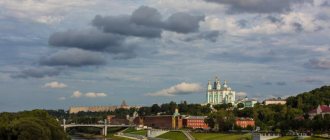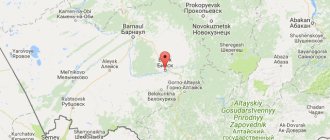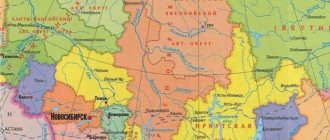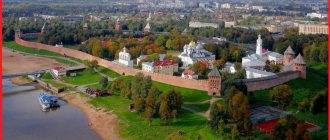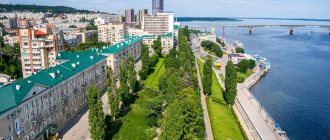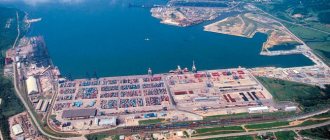The physical and geographical position of the region within the East European Plain is determined by the main features of nature: a temperate continental climate with a significant influence of air masses from the Atlantic, which causes a significant amount of precipitation, the presence of many small rivers, lakes and swamps, a wide distribution of forests and sod-podzolic soils with low fertility. A unique feature of the physical-geographical position is the fact that the Smolensk region, occupying the most elevated section of the East European Plain, is located on the watershed of the three largest rivers in Eastern Europe: the Volga, Dnieper and Western Dvina, which also belong to the basins of three seas - the Caspian, Black and Baltic.
The Smolensk region has a unique political and geographical position, associated primarily with the western border of the state, which accounts for 463 km, which is about 1/3 of the entire perimeter of the region’s border. But this is a special state border with the Republic of Belarus, which is part of the Union State. The regions located on the Belarusian side (Vitebsk and Mogilev) have common historical roots and close modern economic ties with the Smolensk region. (An indicative historical fact is that it was in Smolensk on December 31, 1918 that the Belarusian Soviet Socialist Republic was proclaimed, of which the Smolensk province became a part. However, this lasted only one month, and on February 2, 1919, the Smolensk region became part of the RSFSR.) Smolensk region borders on five regions of Russia: in the north - with Pskov and Tver, in the east - with Moscow, in the southeast - with Kaluga, in the south - with Bryansk. From an economic and geographical point of view, the position is undoubtedly favorable, which creates favorable conditions for the development of all areas of activity in the region. An assessment of the political and geographical situation would be incomplete without pointing out the territorial proximity of the European Union and NATO, which are actually second-order neighbors for the Smolensk region.
The peculiarities of the political and geographical position in different periods of history resulted in numerous wars: the Smolensk region has more than once been the scene of fierce battles holding back the enemy on the outskirts of Moscow. That is why Smolensk has long been called the “City-Key”.
smolensk-map-300×279.jpg
The transport and geographical position of the region is unique: the Smolensk region is the most important transport and communication hub. From east to west, the region is crossed by a transport corridor connecting Central Russia with Western Europe. Its basis is the Moscow-Minsk-Warsaw-Berlin railway and highway. The Smolensk region is often called the “Western Gate to Moscow.” From north to south, the region is crossed by the St. Petersburg – South of Russia road transport corridor. The shortest route from Central Russia to Western Europe passes through the region: the distance from Smolensk to Berlin is 1,470 km. Transport routes connect the region with the largest ports on the Baltic: from Smolensk to Riga – 617 km, to St. Petersburg – 706 km.
In addition, the territory of the Smolensk region passes through: one of the largest gas pipelines "Yamal - Europe", a high-voltage energy bridge "Russia - Belarus - Western Europe", a global fiber-optic telecommunications highway. All transport communications are provided with appropriate infrastructure. The volume of foreign trade freight traffic through the Smolensk region is almost 2/3 of the total Russian freight turnover. The geographical location of the Smolensk region is the most important resource for regional development.
ekonomika.jpg
The economic and geographical position of the Smolensk region as a whole is determined by its proximity to the Moscow region and Moscow as the main economic center of the country, as well as the proximity of St. Petersburg and foreign partner countries (the Baltic countries, the European Union). At the present stage, Moscow with its enormous financial and economic potential plays a decisive role in the socio-economic development of the Smolensk region. This influence is very multifaceted and far from ambiguous: on the one hand, it is investment by enterprises, investment in the economy of the region, on the other hand, the working population, especially educated and enterprising youth, flocks to Moscow. In general, the influence of the capital region can be assessed as very positive. Due to its neighboring position with Moscow, the Smolensk region has the right to claim the location of new production facilities of large companies, including transnational ones, which have established themselves in the capital, but are developing neighboring territories with convenient transport communications and cheaper labor.
Architectural monuments
Among the most ancient architectural buildings in Smolensk, one can highlight the stone fortress. It was built under the leadership of Tsar Fyodor Ioanovich, since in the 16th-17th centuries territorial disputes arose between the Principality of Moscow and the Polish-Lithuanian Commonwealth. About 30,000 hired workers were used for this construction. This architectural monument consists of fortress walls and 38 towers, some of them reaching 33 meters in height. This is the most powerful wall of Russian times. The construction was supervised by the famous Smolensk master Fyodor Kon.
In the Smolensk region, like no other, monuments of Russian culture of the pre-Mongol period have been preserved. Here you can find works in the Baroque style, as well as unsurpassed examples of church construction.
In Smolensk there are several memorial signs and complexes that capture the memory of many military events. Also, many monumental monuments dedicated to famous fellow countrymen appeared here. “The green necklace of the city” is what the residents of Smolensk call their parks and squares.
5-300×225.jpg
Moscow's special influence is manifested in the fact that neighboring regions are turning into its recreational zone. Currently, a phenomenon called the “second home”, used most often for recreational purposes, is gaining enormous proportions. The Moscow region has already been practically developed: more than 3.5 million land plots belong to Muscovites. In the Smolensk region, the eastern regions (Gagarinsky, Vyazemsky) fell into the zone of priority recreational influence, next in line are other convenient territories located in close proximity to the Moscow-Minsk highway, as well as unique natural areas near the Smolensk Poozerie National Park and others protected areas and hunting grounds. In addition, tourist groups from Moscow form the main stream, stimulating the development of cultural and educational tourism.
Economic ties with other neighboring regions are developing less intensively: our neighbors, in particular the Kaluga, Bryansk, and Tver regions, are also more oriented towards Moscow.
War: Smolensk region 1941–1945
Zoya Emelyanova, May 2, 2022, 12:00 - REGNUM The Smolensk region was among the first to take the blow of Nazi Germany, bloody battles were fought here, the population was halved, and never returned to the pre-war level. Smolensk was one of the Soviet cities that received the title of “hero city”.
Anti-aircraft gunners defend Smolensk from German air raids. 1943
Before the war
The Smolensk region as an independent territorial-administrative unit within the RSFSR was formed in 1938 after the abolition of the Western region (Smolensk was also the center). Before the war, the region included 54 districts. The Smolensk region acquired its modern borders in 1944.
Before the Great Patriotic War, according to the 1939 census, 1 million 980 thousand people lived in the Smolensk region. During the Great Patriotic War, the population actually dropped by half. As of 1946, the region had 1.24 million inhabitants. According to experts, to this day the region has not managed to return to its pre-war population size.
Nikolsky Gate. Smolensk October 1943
Smolensk region in 1941
The Smolensk region was among the first territories of the Soviet Union to come under attack by Nazi troops.
Already in June 1941, the German mobile forces of Army Group Center reached the Western Dvina in the Vitebsk region and the Dnieper near Orsha and Mogilev. At the same time, the Soviet divisions of the Western Front of the Red Army from the 13th and 4th armies, after defeat in the border areas, were withdrawn to the rear for reorganization, and by the beginning of the Battle of Smolensk, only 37 of the 48 advancing divisions were able to occupy positions: the number of Soviet divisions was from six to 14.4 thousand people, while Germans - from 17 to 21 thousand.
German promotion from 10 to 17 July
The beginning of the Smolensk battle dates back to July 10. Wehrmacht forces advanced towards Vitebsk and continued to march eastward. On July 16, the Nazis approached the outskirts of the city of Yartsevo - 50 kilometers from Smolensk.
The Germans entered Smolensk on July 16 - the 29th Motorized Division from Guderian's group was the first to break into the city. The city's defenders resisted fiercely, but the forces turned out to be unequal. On July 19, the enemy's 10th Tank Division occupied Yelnya. The 16th, 19th, and 20th armies were surrounded by the Germans. The 13th Army was torn apart by the enemy, and some were surrounded.
German Pz.IV tanks and vehicles near Vitebsk in July 1941, probably from the 20th Panzer Division of the 39th Motorized Corps
On July 21, the Red Army launched a counteroffensive to remove units of the 20th and 16th armies from encirclement. At the same time, on the southern flank of the Western Front, the 21st Army was supposed to resume the offensive with the goal of defeating the enemy’s Bobruisk-Bykhov group and restoring communications with the besieged Mogilev. However, German infantry divisions arriving from near Minsk thwarted the plans of the Soviet command. On July 28, the Red Army finally left the city.
On August 1−21, the Red Army and Wehrmacht troops converged on the Smolensk Bulge. As a result of the enemy's offensive on August 3, Roslavl was occupied. At the same time, on August 8, formations of the 19th and 30th armies resumed attacks in the direction of Dukhovshchina, trying to break through the enemy’s defenses - the attempt was unsuccessful, but showed the German command the capabilities of the Red Army, on the other hand. From August 16 to 21, the Soviet military launched an offensive on the central sector of the Soviet-German front, as well as an attempt to defeat the Elninsky group.
The fourth stage of the Battle of Smolensk lasted from August 22 to September 10. The troops of the Western Front made a new attempt to reach the line Velizh, Demidov, Smolensk, the troops of the Reserve Front received orders to capture Yelnya, and then Pochinok and Roslavl.
Soldiers of the Soviet 20th Army are fighting west of Dorogobuzh. September 1, 1941
On September 6, the Red Army took Yelnya, and this operation became the largest and most successful operation of the Red Army during the Smolensk defensive battle of 1941. It was here, near Yelnya, that Katyusha rockets were first used, which later became legendary. However, Soviet troops were unable to advance further.
For the Red Army, the Battle of Smolensk resulted in heavy losses: during the battle, a total of more than 700 thousand people were killed and wounded, but heroic efforts managed to hold back the Nazi advance towards Moscow, which also contributed to the failure of the Barbarossa plan.
Red Army soldiers near Smolensk
Soviet guards
The appearance of guards divisions in the Red Army is associated with the Smolensk region. For mass heroism, courage of personnel, high military skill demonstrated during the bloody battles of the Smolensk battle, by order of the People's Commissar of Defense of the USSR of September 18, 1941, four rifle divisions - 100th, 127th, 153rd and 161st - were renamed the 1st, 2nd, 3rd and 4th Guards.
Yard on the street Tenisheva in Smolensk during the occupation
Enemy in Smolensk
The occupation of the territory of the Smolensk region by the Nazis lasted more than two years. Already on July 17, 1941, Hitler issued a decree dividing the occupied territories of the USSR into Reich commissariats, general districts, regions and districts, districts. The Smolensk district became part of the Ostland General Commissariat, together with Belarus and the Baltic states.
German plan for occupied Smolensk 1943
The Nazis and their minions were actively in charge in Smolensk. During the occupation, the city was completely destroyed. Of the 170 thousand inhabitants, by the time the city was liberated in September 1943, 20 thousand people remained alive. In the city, 35 thousand civilians and more than 100 thousand prisoners of war were killed, about 90 thousand people were driven into slavery.
The Nazis committed atrocities not only in Smolensk, but throughout the entire region. In total, during the period of occupation of the region, the Nazis killed more than 150 thousand civilian Soviet citizens, took more than 160 thousand to work in Germany, and killed 230 thousand prisoners of war - these are the data of the State Emergency Commission from 1945.
During the period of occupation, the Nazis burned about five thousand Smolensk villages, and there is still no complete list. About 300 villages were burned along with their inhabitants - this is how the invaders took revenge for supporting the partisans: every district of the Smolensk region has its own Khatyn.
“The fascist authorities suspected the residents of the village of Korbutovka of having connections with the partisans and burned the village to the ground. The collective farmer Baranova, who protested against such devastation, had her stomach cut open by the Germans, her face slashed with a knife, and her children’s arms were twisted and their skulls were broken…” - such evidence is given in the data of the State Emergency Commission.
In March 1943, the Nazis rounded up about 400 residents of neighboring villages into the village of Chertovka and burned them. Concentration camps for civilians were created in the region - old people, women, and small children were driven there.
At the beginning of March 1942, near the village of Serebryanka, a partisan detachment ambushed a German food train and 14 Nazis were killed. And on March 5, the Nazis drove the villagers - 19 people - into a barn, and then burned them alive.
On the outskirts of the village. In Masalovka there were piles of mutilated corpses of small children, women and old people. In this place, the fighters counted 160 corpses. This was the entire population of the village
Guerrilla movement
After the occupation of Smolensk, more than 40 underground groups were created in the city and nearby suburbs, which included about 500 people. Their participants worked against Nazi propaganda, helped partisan detachments, obtained food and weapons for the partisans and carried out sabotage. In Smolensk in December 1941, an underground center was created, which led the underground in the city, on the railway, in the suburbs and villages and had connections with the regional committee of the All-Union Communist Party (Bolsheviks) and with the headquarters of the Batya partisan unit.
In July 1942, the underground was exposed by the Nazis - its leader Boris Popov , as well as 165 other participants, were caught by the Gestapo and, after brutal torture, shot in Readovka - in 1966, a memorial was erected on their mass grave.
However, the partisan movement, in spite of everything, continued to actively operate behind enemy lines - by the spring of 1942, the partisans had liberated 25 of the 42 occupied regions from the occupiers, and they became the “partisan regions” - the base for the advancing regular army.
German mechanized infantry on defensive maneuvers
Liberation of Smolensk
In the summer of 1943, the Red Army, after defeating the Germans near Moscow, Stalingrad and the Kursk Bulge, drove the enemy from the territory of the USSR and began to liberate the Smolensk region.
During the Smolensk operation of 1943, Soviet troops, together with partisans, carried out the Spas-Demenskaya, Elninsk-Dorogobuzhskaya, Dukhovshchinsko-Demidovskaya, Smolensk-Roslavlskaya operations and, during bloody battles from August 7 to October 2, completely cleared the Smolensk region of the Nazis.
After liberation, the Smolensk region became a rear area for Soviet troops - hospitals, repair bases, airfields, and army warehouses were created here.
On the Western Front in anticipation of the offensive in the Smolensk direction. From left to right: representatives of the Supreme Command Headquarters, Air Marshal A.A. Novikov and Marshal of Artillery N.N. Voronov, member of the Front Military Council, Lieutenant General N.A. Bulganin and the commander of the Western Front, Colonel General V.D. Sokolovsky
Heroes of the Smolensk region
260 natives of the Smolensk region were awarded the title of Hero of the Soviet Union, 10 thousand partisans and underground fighters were awarded orders and medals. The title of Hero City was awarded to Smolensk on May 6, 1985.
Among the most famous Heroes of the Soviet Union from the Smolensk region is Mikhail Egorov , who, together with Meliton Kantaria, hoisted the Victory Banner over the Reichstag in May 1945.
Bust and grave of Egorov in the Square of Memory of Heroes in Smolensk
(ss) Sergey Semenov
Smolensk process
In December 1945, the Smolensk trial took place in Smolensk against a group of former Wehrmacht and SS soldiers who took part in war crimes in the region.
The main culprit of the crimes was recognized as General Maximilian von Schenkendorff , the head of the support and logistics units of Army Group Center; by that time he was no longer alive. Ten people were in the dock: the translator of the 335th and 490th security battalions, who personally led a number of punitive operations, Roman-Robert Kirschfeld ; medical assistant of military hospital No. 551, who participated in the bleeding of Soviet civilians, including very young children, Rudolf Modish ; non-commissioned officer of the 335th security battalion, participant in the massacres of Soviet prisoners of war Willie Weiss ; corporal of the security battalion, who also participated in the killings of prisoners of war and civilians Kurt Gaudyan ; Corporal of the 335th Security Battalion Fritz Gentschke ; Corporal of the 335th Security Battalion, who participated in the murders of prisoners of war and civilians, Erich Müller ; Corporal of the 335th Security Battalion Willi Krause ; senior soldier of the 350th Infantry Regiment, company dog breeder Josef Reischman ; squad commander of the 490th Security Battalion, Erich Everts ; Corporal of the 335th Security Battalion Heinz Winkler .
Thus, Joseph Reischman trained dogs and, in his “free time” from work, hounded civilians with dogs; in particular, he hounded and raped a 14-year-old girl. He, along with other criminals, took part in the mass execution of civilians in the village of Monastyrshchina and in several villages near Smolensk.
“The partisans were elusive, and the German command decided to suppress the partisan movement by mass execution of innocent civilians,” said Roman-Robert Kirschfeld at the trial, who personally commanded the punitive detachment, shot villagers, and burned houses (quote from the History portal. RF).
The court sentenced seven of the ten defendants to death by hanging; the sentence was carried out on December 20, 1945 on Zadneprovskaya Square - in front of 50 thousand Smolensk residents. The rest were sentenced to 20, 15 and 12 years in prison.
1-300×200.jpg
The neighborhood with the Republic of Belarus creates favorable preconditions for the socio-economic development of the region in many areas: industry, trade, tourism, etc. Joint events (exhibitions, fairs, conferences) are regularly held under the auspices of the Union State. The influence of Belarus also has a beneficial effect on the development of tourism: joint tourist routes are currently being developed. In addition, sanatorium and resort services provided in Belarus at fairly low prices with a high level of service have led to an increase in outbound tourist flows from the Smolensk region.

